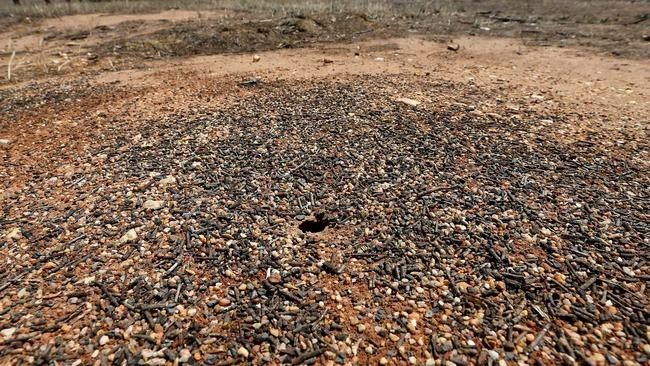Quick Facts
| Attribute | Details |
|---|---|
| Scientific Name | Iridomyrmex purpureus |
| Common Name | Meat Ant |
| Size | Workers: 6–12mm, Queens: 14–16mm |
| Lifespan | Queens: ~5 years, Workers: ~1 year |
| Colony Type | Monogynous (Single Queen) |
| Foraging | Diurnal (Daytime Active) |
| Habitat | Open forests, woodlands, urban areas |
| Nuptial Flights | November–December (Late Spring–Early Summer) |
| Hibernation | No; reduced activity in winter |
| Founding Type | Fully Claustral (No feeding needed) |

1. Why Keep Meat Ants?
The Meat Ants (Iridomyrmex purpureus) are a powerhouse of Australian ecosystems. These ants dominate with sprawling colonies—sometimes thousands strong—and clean up carcasses while outcompeting invasive species. They don’t sting but pack a punch with strong mandibles and formic acid spray. Diurnal and sun-loving, their gravel-covered nests are iconic in Aussie landscapes. Perfect for experienced keepers craving active, aggressive ants, but beginners beware—these escape artists demand tight setups! 🐜
2. Habitat and Distribution
Meat Ants thrive across Australia in:
- Open Forests and Woodlands: Sunlit clearings for their massive nests.
- Urban Areas: Parks, gardens, and footpaths host their gravel mounds.
- Grasslands and Bushland: Dry, open areas suit their heat-loving nature.
.Nesting Preferences
- Gravel-Covered Nests: Regulate temperature and deter rivals.
- Sun-Exposed Sites: Avoid shade for optimal warmth.
- Deep Underground Chambers: Colonies extend meters below ground.
🔗 Related Guide: How to Find Queen Ants in Australia
3. Catching a Meat Ant Queen – Nuptial Flights
Meat Ant queens take flight in large numbers, but catching one is tricky—workers from rival colonies may attack newly mated queens.
When to Look
- Season: Late spring to early summer (November–December).
- Weather: Warm, humid days after rain.
- Time: 9 AM–1 PM, when flights peak.
How to Spot a Meat Ant Queen
- Size: 14–16mm, larger than workers.
- Thorax: Thick, built for wing muscles.
- Behaviour: Newly mated queens wander solo, seeking nest sites.
🔗 Related Guide: What to Do with a Queen Ant After Capture
4. Founding a Colony – Test Tube Setup
Meat Ant queens are fully claustral, sealing themselves off without needing food until workers emerge.
Test Tube Setup
- Size: 16–20mm wide, glass or plastic.
- Water: Fill one-third, seal with cotton.
- Plug: Cotton for airflow and security.
- Conditions: Dark, undisturbed, 24–28°C.
Next Steps
- Move to a formicarium when the colony hits 20–30 workers.
🔗 Related Guide: The Perfect Test Tube Setup for Queen Ants
5. Housing Your Colony
Meat Ant colonies grow fast and need spacious, secure nests for proper Meat Ant care.
Best Nest Types for Meat Ant Care
- Acrylic Nests: Clear for observation, but plan for large colonies.
- 3D-Printed Nests: Expandable for growing empires.
- Ytong Nests: Retain moisture, ideal for dry Aussie climates.
- Naturalistic Setups: Mimic gravel mounds for mature colonies.
🚨 Pro Tip: Meat Ants are escape masters—use tight lids and barrier coatings like fluon!!
🔗 Related Guide: Moving Your Queen Ant to a Formicarium
6. Feeding Your Meat Ants
Despite their name, Meat Ants need a balanced diet of proteins and sugars. Proteins fuel brood growth; sugars energize workers.
Recommended Foods
- Proteins: Crickets, mealworms, cooked chicken, or fish flakes.
- Sugars: Honey water, sugar water, or ripe fruit.
- Treats: Small pinches of crushed almonds or peanuts (sparingly to avoid mold).
Feeding Schedule
- Offer food every 2–3 days.
- Remove leftovers promptly to prevent mould.
🔗 Related Guide: The Ultimate Ant Feeding Guide
7. Seasonal Care – Winter Slowdown
Meat Ants don’t hibernate but dial back activity in cooler months.
Feeding: Reduce to once weekly; keep fresh water available.
Period: May–August.
Temperature: Maintain 18–20°C.
8. Troubleshooting Common Issues
Problem: Queen Not Laying Eggs
- Disturbance: Limit checks to every 1–2 weeks.
- Temperature: Ensure 24–28°C for founding.
- Infertile Queen: Male-only eggs suggest she didn’t mate successfully.
🔗 Related Guide: How to Keep Your Ants Safe from Mites and Pests
8. Final Thoughts
Meat Ants (Iridomyrmex purpureus) are a thrilling challenge for seasoned ant keepers. Their bustling colonies, sun-loving habits, and bold behavior make Meat Ant care a standout for Australian species lovers. Be ready for their aggression and escape antics with secure setups and careful handling.
🐜 Would you tackle a Meat Ant colony? Share your setup ideas in the comments!
🐜 Would you tackle a Meat Ant colony? Share your setup ideas in the comments!

